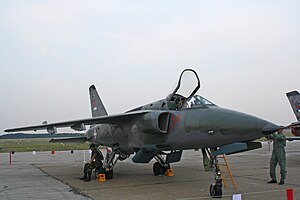J-22 Orao
| J-22 Orao | |
|---|---|
 |
|
| A Serbian Air Force J-22 Orao of the 241st Fighter-Bomber Aviation Squadron. | |
| Role |
Attack aircraft Reconnaissance aircraft |
| Manufacturer | SOKO |
| Designer |
VTI - Yugoslavia INCAS - Romania |
| First flight | November 1974 |
| Introduction | 1978 |
| Status | Active |
| Primary users |
Yugoslav Air Force Serbian Air Force Bosnian Air Force |
| Variants | Avioane Craiova IAR-93 Vultur |
The Soko J-22 Orao (English: Eagle) is a Yugoslav twin-engined, subsonic ground-attack and reconnaissance aircraft. It was designed as a single-seat main attack version or as a combat capable two-seat version for advanced flying and weapon training. It was developed as a joint Yugoslav-Romanian project in the 1970s for the air forces of both nations, SOKO built it in Yugoslavia, and Avioane Craiova built it as the IAR-93 Vultur in Romania.
On 20 May 1971, the governments of Romania and Yugoslavia signed an agreement for the formation of YuRom, a joint R&D venture. The program was headed by Dipl. Dr. Engineer Teodor Zanfirescu of Romania and Colonel Vidoje Knezević of Yugoslavia. The aircraft was intended as a replacement for the lightly armed Soko J-21 Jastreb and the Republic F-84 Thunderjet, then in the JNA arsenal.
The requirements called for a light aircraft to be built on a simple structure, using locally produced equipment and avionics, tough (able to operate on grass or damaged runways), easy to maintain and reliable. The aircraft was of conventional twin-engine, high mounted wing monoplane configuration with all flying surfaces swept. The designers originally planned a single-engined supersonic aircraft, but Britain would not authorize the license for the engine the designers wanted (due to Romania being in the Warsaw Pact), so the less-powerful Rolls-Royce Viper was chosen as the powerplant, as Soko had experience with license-building this engine. It was originally intended that an afterburner would be developed for the Viper engines, but there were prolonged difficulties with this project, meaning that none of the pre-production aircraft featured it, and neither did early production examples. During the 1980s, both countries developed slightly different versions to take advantage of the afterburning engines that had since become available.
The Yugoslav prototype 25002 made its first flight in November 1974 from Batajnica Air Base near Belgrade, with Major Vladislav Slavujević at the controls.
...
Wikipedia
